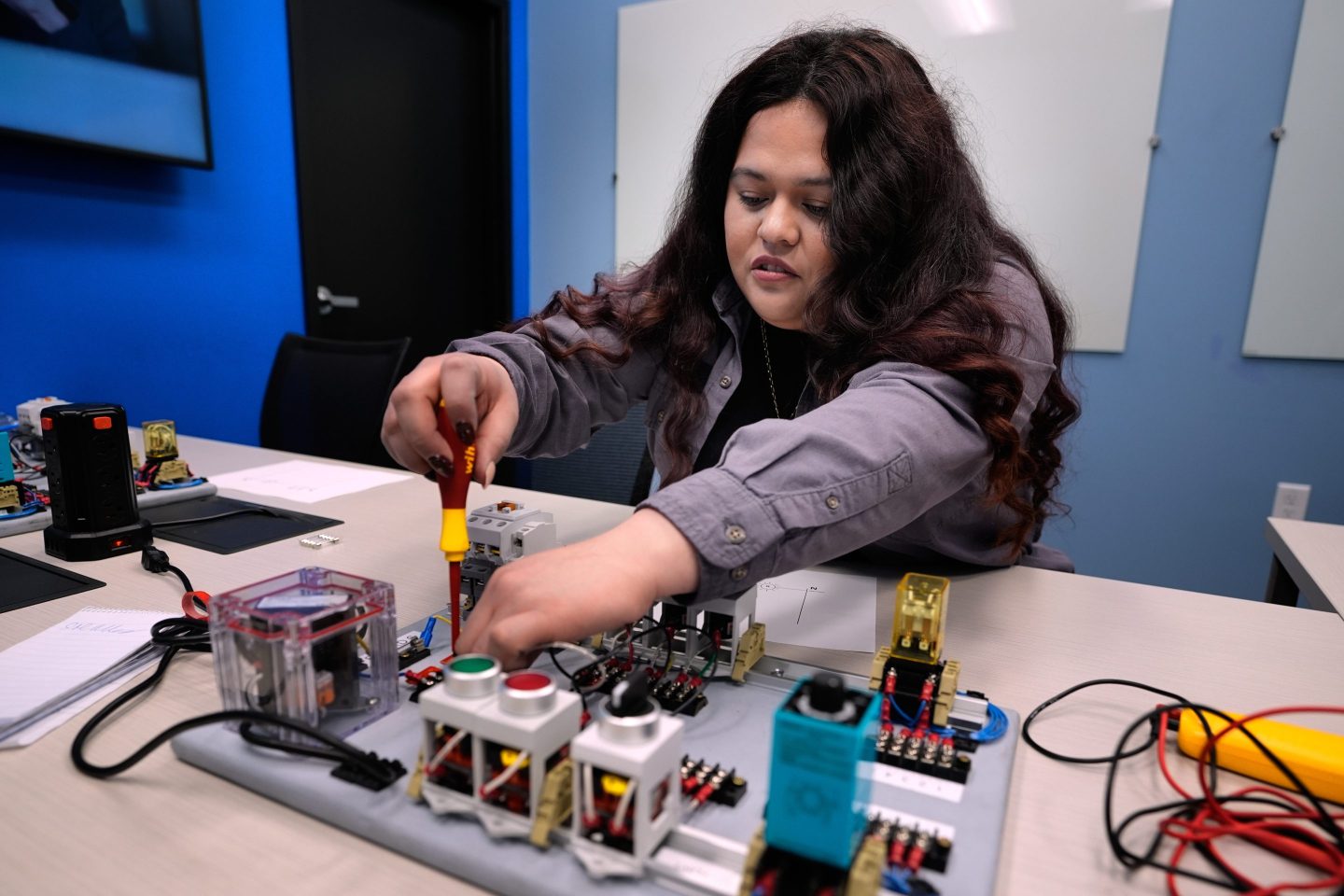The 1966 science fiction film Fantastic Voyage imagined a technology that could shrink people to microscopic size so they could use a tiny submarine to travel through a person’s body and repair a blood clot in an injured scientist’s brain.
Today a Paris-based startup called Robeauté announced it has secured $28 million in venture capital funding to essentially make this sci-fi concept a reality. Well, not the shrinking people part. The company has created a self-propelled microrobot, just 1.8 millimeters long—approximately the size of a grain of rice—that can travel inside the human brain to assist neurosurgeons. The company is targeting tissue sample collection for biopsies as its first use case, but Robeauté hopes it has designed its robot to be a cargo-agnostic carrier that could eventually be used to deliver cancer drugs directly to otherwise inoperable and hard-to-treat brain tumors or implant electrodes deep inside the brain to provide treatments for Parkinson’s or other brain disorders.
The Series A funding round is being co-led by London-based Plural, Cherry Ventures, and Kindred Ventures. Other investors participating in the funding include LocalGlobe, Think.Health, and a previous investor APEX Ventures. Also participating in the funding round as a strategic investor is Brainlab, a Munich-based company that makes software and medical devices to assist in surgery and radiotherapies.
Robeauté plans to use the funding to help it gain U.S. Food and Drug Administration approval to begin human clinical testing of its microrobot, which has already been successfully trialled in living animals. The company is targeting 2026 for initial human trials. It also plans to open offices in the U.S.
Robeauté is not the only company pioneering micro and even nanoscale robots for use inside the human body. Ediatx, a Silicon Valley startup, has developed Pillbot, a tiny robot that a person can swallow and that can wirelessly transmit images and other data back to doctors from inside a person’s digestive tract. It’s currently undergoing human clinical trials and Ediatx has said it anticipates receiving FDA approval this year. BioNaut Labs, another startup that has attracted more than $63 million in venture capital funding to date, is working on robots small enough to be injected into the body’s cerebrospinal fluid and which can then be guided to the brain using magnets in order to treat certain brain tumors or other brain disorders. The FDA has granted BioNaut clearance to test its robots in the treatment of certain brain tumors and a rare pediatric brain disease.

Veteran roboticist and computer scientist Bertrand Duplat, Robeauté’s cofounder and CEO, spent decades designing robots for extreme environments, including in the depths of the ocean, radioactive sites, and in outer space. But he turned his attention to robots that might be able to operate inside the human brain after his mother was diagnosed with an inoperable glioblastoma. “It was impossible to do anything,” he said. “The idea really came out of the pain and frustration at the inability to reach any of these meaningful areas of the brain.”
Duplat had seen Fantastic Voyage, and he began to wonder why roboticists couldn’t now actually create tiny vehicles to travel inside the body similar to the microsubmarine that appears in the movie.
In 2017, he cofounded the company with Joana Cartocci, who had worked with one of Duplat’s friends as the operations manager for the public art installation that used a range of advanced technologies to turn the Eiffel Tower into a virtual forest of individualized trees every night during the 2015 COP21 climate talks in Paris. (The project planted a real tree in one of seven reforestation projects around the world for each virtual tree that the public created on a smartphone app to be displayed on the monument.) She is now Robeauté’s chief operations officer.
The company had to figure out how to create a robot small enough to operate inside the brain without causing damage. Doing so required making multiple advances in robotics, electronics, and microfabrication. The team has been granted more than 50 patents for innovations related to their microsurgical robot’s development. “It was crazily hard,” Duplat said of the process to develop the company’s microrobot. “It required multiple building blocks, and it took five years to get all these initial building blocks put together, working with different labs. It was very interdisciplinary.”
Robeauté’s robot includes the world’s smallest vehicle-mounted engine which powers a tiny propeller that the robot uses to pry open an initial crack in a patient’s brain tissue. It then uses the force of the surrounding tissue itself acting on the sides of the robot to propel it through the brain. The robot is designed to travel within the brain’s extracellular matrix, a three-dimensional structure composed of carbohydrates and other proteins that surround brain cells, providing a kind of physical scaffolding around which the brain is constructed. It also protects the neurons and plays some role in regulating their function. By traveling within this matrix, the robot is designed not to harm any of the brain cells as it moves.
The robot follows a course through this matrix to a target tissue that is preprogrammed by surgeons using detailed three-dimensional brain maps derived from MRI scans and other brain imaging methods. But Robeauté had to develop software, including various machine learning techniques, that let the robot orient itself within the extracellular matrix and follow the correct path to the target brain region. Duplat compares this navigational system to a kind of three-dimensional GPS for the brain.
The robot trails a very fine wire behind it that lets it communicate with its guidance and control software, which is housed on a computer external to the tiny robot, as well send data back to the surgeons operating it. The wire also maintains a pathway that surgeons can use to relay microsurgical tools or possibly drugs to the robot, and that might allow the robot to send tissue samples back to the surgeons from deep inside the brain without the robot having to exit the brain to bring back the sample.
One of the biggest issues with the majority of today’s neurosurgical tools and probes is that they are linear—they can only access portions of the brain that are in a direct line from the point on the surface of the brain where they are first inserted. Robeauté’s robot, by contrast, can follow curved paths through the brain, approaching diseased tissue via routes where the robot is least likely to damage vital brain regions, Duplat said. He also said the robot can access multiple locations on a tumor or lesion from a single entry point, something that is not possible with existing brain biopsy tools.
Taking tissue samples from multiple places on a tumor is increasingly seen as vital for conducting an accurate genetic analysis of certain cancers, since different cells even in the same tumor can have slightly different genetic compositions and can express proteins differently. This information is, in turn, important for finding the most effective possible treatment.
“Robeauté’s technology doesn’t just have the potential to transform neurosurgery—it could also fundamentally change how drug companies find the best solutions for patients,” Ian Hogarth, a partner at Plural, said.
Cartocci said that neurosurgeons have been among Robeauté’s biggest supporters to date. “We very quickly saw the medical community response and scientific and technical community response [to Robeauté’s idea] was overwhelming and so many people opened doors for us and wanted to be part of the mission,” she said. “They recognized the need for this solution and they recognized the intellectual challenge of trying to achieve it.”
Duplat said it was only when the company conducted its first validation tests of its microrobot in animal cadavers in December 2021 that it became clear to him and the rest of the team that the company could actually succeed. The company has since tested the product in the brains of human cadavers, as well as conducting live animal tests. The company currently employs about 20 people, the majority of them scientists. It has hired talented researchers from the robotics lab at the Sorbonne, as well as from throughout the world.













